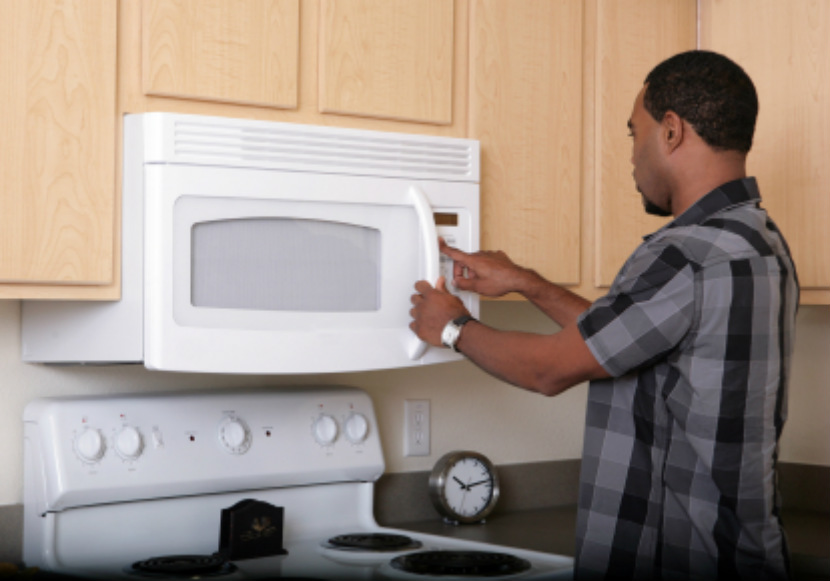
Microwaves are a convenient way to thaw, cook and reheat food. Many people have questions about how microwaves affect their health and the safety of their food. Read on to learn how you can safely use a microwave for food preparation.
Using a Microwave: How it works
We often hear people saying they are going to “nuke” their foods, believing that microwaves release radioactive energy. This is not true! Microwaves work by causing the water molecules in food to move around. The rapid movement causes a quick rise in temperature, which heats the food. This is why microwaves can cook foods in a shorter period of time compared with regular ovens.
Microwaves should not be confused with other forms of energy rays, like X-rays. Microwaves do not cause food or the oven itself to be radioactive. Once the microwave is shut off, the microwaves disappear – they do not remain in the food or the oven.
Microwaves are safe for thawing, cooking and reheating food
In Canada, there are rules that limit the amount of energy allowed to leak from microwave ovens. There is also no evidence to show that foods prepared in the microwave are harmful.
As with all other cooking methods, food safety should be practiced when using microwaves. Foodborne illnesscan happen with improper food handling and cooking. This is especially important with raw foods like meats, seafood, poultry and eggs. See the food safety tips below for thawing, cooking and reheating foods in the microwave.
Microwaves and nutrient contents of foods
All cooking methods have some effect on the nutrients in food. This is especially true if you overcook the food, as this can cause nutrients to be lost. Since cooking times are shorter and less water is used in microwave cooking, there are fewer nutrients lost. To help preserve nutrients when microwaving food, it is best to heat your foods evenly. Here are some steps to help keep the nutrients in your foods:
- Defrost frozen foods completely before cooking. Frozen or thawed portions in the same food will lead to uneven heating.
- Cut food into small pieces.
- Remove food from the bone.
- Add liquid (such as water, juice or gravy) to solid foods.
- Stop part way through cooking to stir or rotate foods.
- Cover food with microwave-safe lid or microwave-safe plastic wrap to trap steam.
- Use only products labelled as “microwave-safe”.
- Follow directions for “standing times” after a food is heated. Following the directed standing time is important as during this time the food continues to cook to reach a safe internal temperature. This information is often found on food packaging or recipes.
Top 10 tips to cooking safely and nutritiously with a microwave
Microwaves can be convenient in helping you prepare foods more quickly – and there’s no need to lose out on safety or nutrition! Keep these 10 tips in mind:
- Remove food from any packaging, including plastic wrap, freezer cartons and/or Styrofoam trays before defrosting and cooking. These items are not safe to use in a microwave. Do not reuse trays or containers that come with microwave convenience foods. These may be made for one time use only.
- Do not use metal pans or aluminum foil in the microwave – this can damage the oven and cause uneven cooking. Use only glass, plastic or stoneware that are labelled “microwave safe”.
- Do not defrost foods in the microwave for more than 2 hours. Set a timer as a reminder.
- Take steps to make sure food is heated evenly (see steps above) so that you do not have any “cold spots”. Bacteria can grow quickly in these under heated areas.
- Never partially cook meat. If you are using the microwave to speed up cooking time, it must be followed right away by another cooking method like an oven or stovetop. Never cook whole poultry, including turkey in the microwave. Do not use the microwave to cook frozen raw breaded chicken products. This can result in uneven cooking, and some parts of the product may be undercooked.
- Cook food thoroughly – use a food thermometer to make sure your food has reached a safe internal temperature. Test the temperature in several locations, especially in the thickest area of the meat. If you are reheating leftovers, always heat them to at least 74ºC (165ºF).
- Be careful when heating foods and removing them from the microwave. Use protective oven mitts or potholders.
- Avoid overheating liquids by stopping the microwave part way through the heating process to stir the liquid.
- Do not operate the microwave if the oven door does not close firmly or is damaged in any way.
- Clean your microwave often with water and a mild detergent – inside and out.
Try some of these easy recipes for microwave cooking:
Rise and Shine Breakfast Sandwich
Grilled Asparagus and Sweet Potato Curry
Maple Carrots and Parsnips
How can a dietitian help?
Dietitians can support you throughout many phases of your life from pregnancy to eating well when you are older. Counselling sessions with a dietitian can also help you to prevent and treat health conditions like diabetes and heart disease. Your dietitian will work with you to give you personalized advice that meets your lifestyle and goals. Connect with a dietitian today!
Bottom line
Microwaves can be a safe and convenient tool for cooking food if you follow a few simple steps. Cooking with a microwave can even help keep nutrients in your food - an added bonus!
You may also be interested in:
Food Safety: Understanding Foodborne Illness
Food Safety – True or False
Top 5 Reasons to See a Dietitian
This article was written and reviewed by dietitians from Dietitians of Canada.
Last Update – May 6, 2022